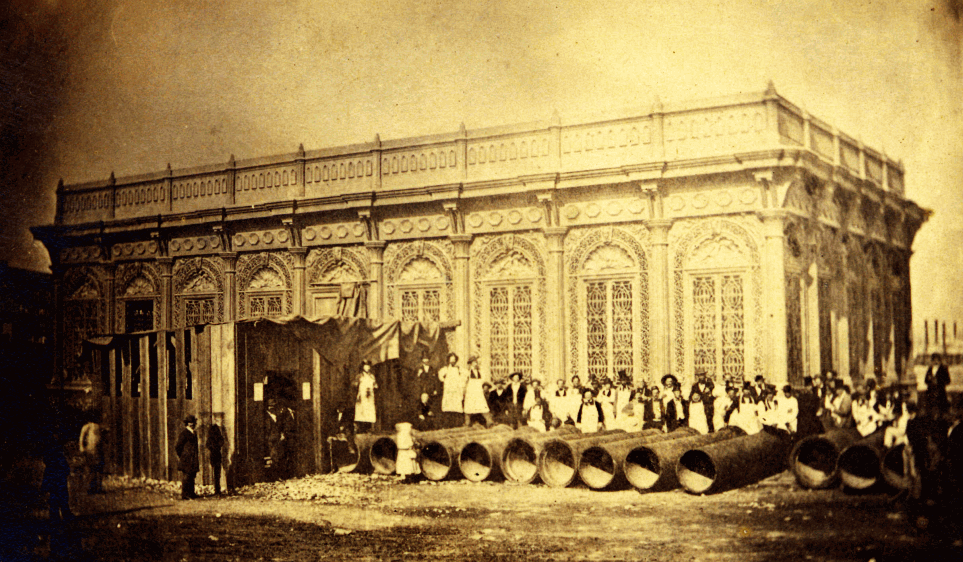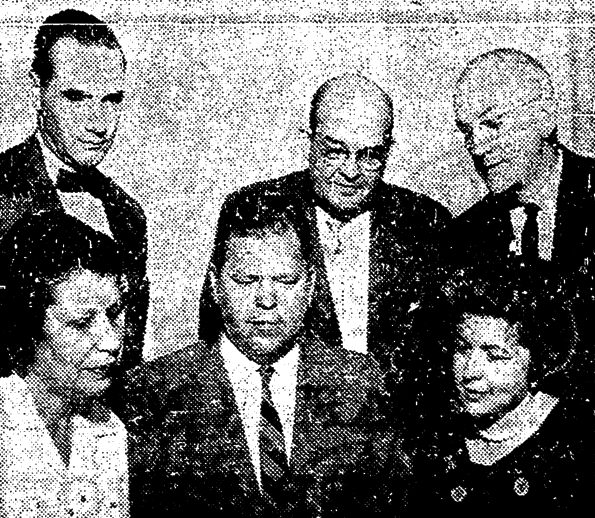|
Today in New Orleans History |
|
|
July 29


 To receive an update for each day in New Orleans history,
join our facebook page - Today in New
Orleans History.
 To receive an update for each day in New Orleans
history, join our facebook page
- Today in New Orleans History
Josephine Louise Newcomb, born in Baltimore on October 31, 1816 to Mary Sophia Waters and Alexander Le
Monnier, received her education in Baltimore and in her father's native France. After her mother died, Le Monnier went
to live in New Orleans, where her older sister Eleanor Anne and brother-in-law William Henderson had settled. There,
Le Monnier met Warren Newcomb, and the couple married in Christ Church Cathedral on December 15, 1845. The couple moved
to Louisville, KY, and had a son, Warren, Jr., who died shortly after his birth in 1853. They later moved to New York, where
Josephine gave birth to their second child, Harriott Sophie Newcomb, on July 29, 1855. Harriott Sophie
died in 1870 at the age of 15. Through Josephine's philanthropy, H. Sophie Newcomb Memorial College at Tulane University
was established as a memorial to her daughter. Following an initial donation of $100,000, Josephine made gifts totaling
$3 million. She died on April 7, 1901. In December 2005 the Tulane University board of directors announced that
the university would be reorganized on July 1, 2006, to accommodate needed changes due to losses following Hurricane Katrina.
The board also approved the recommendation of a special Tulane Renewal task force to name a revised, co-educational, single
undergraduate college Newcomb-Tulane College. Related reading: Newcomb College, 1886-2006: Higher Education for Women in New Orleans Telephone Area code 504 covers the greater New Orleans, Louisiana, area. Besides New Orleans itself (Orleans
Parish), it includes all of St. Bernard and Plaquemines parishes and most of Jefferson Parish. 504 was one of the original
area codes created in 1947, and originally covered all of Louisiana. In 1957, most of the state west of the Mississippi River
was split off as area code 318. In 1998, the western portion of the old 504 territory, including Baton Rouge, became area
code 225. In 2001, much of southeastern Louisiana was split off as area code 985, to both the west and the north of 504. Several
of New Orleans' downriver suburbs switched to 985 in 2001 as well. However, after Hurricane Katrina in late August 2005, much
of this area switched back to 504. These communities are now being served with dialtone from telephone switching facilities
in New Orleans following near-total destruction of local switching facilities due to flooding from Katrina. Permissive use
of 504 alongside 985 to reach these downriver communities began on July 29, 2007. Mandatory use of 504 to
again reach these communities began on May 1, 2008. These communities are on both sides of the Mississippi River in lower
Plaquemines Parish, including Pointe à la Hache on the east bank, with Port Sulphur, Buras, and Boothville on the west
bank. (Wiki) BOWERS, Charles Houma Dixon, physician, civic leader. Born, Houma, La., June 6, 1892; son of Rev.
Frank B. Bowers and Margaret Jackson Bowers; one of nine children. Education: New Orleans University (now Dillard
University), B.A., 1915; M. A., 1923; Meharry Medical School, M. D., 1919. Married Cassie Collins, 1920. Children:
Mrs. Dee Ione Bowers Willoughby of Boston, Mass., Dr. Charles H. D. Bowers, Jr., of New Orleans. Positions: staff
of Flint-Goodridge Hospital, 1919; chief of medical staff at Flint-Goodridge Hospital, 1938-1969; director of state and city
venereal disease program; university staff physician, Dillard University, 1935-1969; admitting officer and director of Out-Patient-Clinics,
Flint-Goodridge Hospital; president, Original Illinois Club, 1956-1958; volunteer service to the Louisiana Interscholastic
Athletics Association, 1939-1969. Awards and memberships: Rosenwald Fellow at the Third Medical Division of New
York University Bellevue Hospital; Meharry Medical College President's Award for 50 years' service; Sunbeam Bakery Award;
Louisiana Coca-Cola Company's Community Service Award for service to local young people; Distinguished Alumni Award, Dillard
University, 1964; Blue Devil Sports Award, Dillard University; Churchman Award from First United Methodist Church; Omega Psi
Phi Award, 1958, 1967; Orleans Parish Medical Society Award; Rosenwald Dubloon Award for Outstanding Historical Doctors; secretary,
board of trustees of New Orleans University; first president, Dillard University Alumni Association, 1936; New Orleans University
Alumni Association, 1935; New Orleans University Alumni Association, 1919-1930, secretary; New Orleans Medical Association;
Louisiana State Medical Association; the Eagle Life Insurance Co., officer, 1930; Bunch Social Club, Alpha Alpha Boule Sigma
Pi Phi Fraternity; Chi Delta Mu; Omega Psi fraternity; Original Illinois Club. Religion: Methodist. Member
of First Street United Methodist Church of New Orleans, 1919-1969. Died, July 29, 1969. C.T.
Sources: New Orleans University, Seventy Years of Service, New Orleans University (1935); "Dr. Bowers Gets Alumni
Award," Dillard Bulletin, XXX (December, 1964); Funeral Program Obituary, July 31, 1969; Dr. and Mrs. Charles H. D. Bowers,
Jr., of New Orleans, La. From http://lahistory.org/site19.php Thomas Henry Casanova, III, known as Tommy Casanova, was born in New Orleans on July 29, 1950.
Now an ophthalmologist in Crowley, Louisiana, he played football for the LSU Tigers and the Cincinnati Bengals.
He is also a Republican former member of the Louisiana State Senate, having served from 1996 to 2000. (Wiki) The Carondelet streetcar began its run on July 29, 1866. This uptown line ran on
its namesake street from Canal Street to Napoleon Ave. At its most extensive, it also ran on Freret Street from Napoleon to
Broadway, on trackage that eventually became part of the Freret line, and it crossed Canal Street into the French Quarter,
pioneering the route of the later Desire line. It ceased on September 7, 1924. (Wiki) Andre Cailloux (1825 – May 27, 1863) was one of the first black officers in the Union Army to be
killed in combat during the American Civil War. He died heroically during the unsuccessful first attack on the Confederate
fortifications during the Siege of Port Hudson, Louisiana. Accounts of his heroism were widely reported in the press, and
became a rallying cry for the recruitment of African Americans into the Union Army. Born a mixed-race slave in Louisiana in
1825, Cailloux lived his entire life in and around New Orleans. As a young man, Cailloux had been apprenticed in the cigar-making
trade. He was owned by members of the Duvernay family until 1846, when his petition for manumission, which was supported by
his master, was granted by an all-white police jury in the city of New Orleans. Upon gaining his freedom, Cailloux earned
his living as a cigar maker. Prior to the beginning of the Civil War, he established his own cigar-making business. Though
his financial circumstances were modest, Cailloux became recognized as a leader within the free Afro-French Creole community
of New Orleans. The story of Cailloux's heroism preceded the return of the captain's body to New Orleans. When his funeral
was held there on July 29, 1863, Cailloux was honored by a long procession and thousands of attendees. He
was buried in Saint Louis Cemetery. His heroism achieved mythic proportions during the Civil War and was frequently recounted.
He was often referred to as example by leading proponents of African-American soldiers serving in the Union Army. (Wiki)
|
|
|

To receive an update for each day in New Orleans history,
join our facebook page - Today in New
Orleans History.
Analytics |



